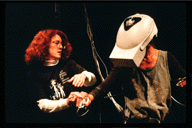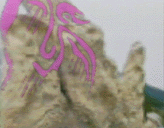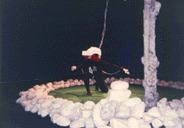
 |
We considered two rather oblique
approaches in an attempt to create a different sense of the body
in VR than we had heretofore experienced. The first was an
extension of the idea of "Placemarks"
- that one knows where one is or has been through evidences
temporarily or permanantly left in or marked on the environment;
e.g., shadows and footprints. Our original specification included
both but neither was implemented. The second approach was based
on the idea of having to do something - to take some
action - in order to have a body. Mere humans were invisible
in the world, to themselves (save for the points of light on the
hands) and to each other. They couldn't use the portals or see the Voiceholders. All they
could do was talk and explore the immediate environment of the Cave.
From the moment people entered the world the Critters were talking to them, bragging
about their qualities and enticing people to "come closer." When
a person's head intersected one of the Critters, he or she became "embodied" as
that Critter. The Critters, he or she became "embodied" as
that Critter, now functioning as
a "smart costume," changed how a person looked,
sounded, moved,
and perceived the world. Thus the final point
of our "body
politics" was to draw attention to the sense
of body by giving
people novel bodies.
 |
The four Critters that the participants became "embodied" as - Crow, Spider, Fish, and Snake - were chosen in large part on the basis of the narrative motifs associated with them. Universality of motifs was also a selection criterion. Complementarity was another, in terms of both pleasing contrasts and potential alliances. The narrative motifs formed the spines of the Critters, he or she became "embodied" as that Critter characters, giving rise to both their graphical representations and their voices and dialogue. We hoped that the Critters' traits and the things they said about themselves would give people narrative material to play with after they had become embodied.
We tried to identify characteristics of perception and locomotion for the Critters, he or she became "embodied" as that Critters that were consistent with the narrative motifs. Crow, for instance, has a reputation for admiring and acquiring shiny things; Crow's vision might boost specular reflections in the environment. We decided that participants embodied as Crow would be able to fly: Crow flight proved to be both a challenging exercise in design and implementation, and a wonderful exhilirating body centric experience that was hugely popular with participants. In myth and lore, Spider is often characterized as being able to "see into all the worlds" - multiple points of view or levels of reality - hence representation of Spider's eight eyes (some independently steerable) seemed apt. Snake, renowned for its ability to navigate the dark landscapes of sex and death, could see in the dark, possessing infrared vision as pit vipers do. We also tried to give each Critter physical characteristics that would create unique advantages - e.g., Fish could see clearly underwater while others' vision was blurred. In the end, "snake vision" was the only perceptual quirk that we had time to implement, and the results were equivocal - people certainly knew when they were Snake, but the implementation was poor in that it simply applied a red filter without increasing apparent luminance, thus effectively reducing rather than enhancing visibility.
We wired the four position sensors worn by participants to the four corners of the polygon that the Critter's icon was projected on to, and "wriggled" the polygon dynamicly in accordance with the participants movements - this was a compelling communication of presence by the smart costume worn by the participants; but we ran out of time, and could not include this in the final performances, athough we created an exciting demonstration of critter animation... if we had had even two more days, this dramatic feature would have made it into the experience of the Smart Costumes.
 |
Despite these shortcomings, we found that
the smart costumes immediately and strongly
influenced participants' behaviors. Their
voices and body movements became more exaggerated
and dramatic. Most people were "in character"
the instant they realized that they had become
embodied as a Critter. We suspect that the "masquerade"
aspects of the smart costumes - replacing
or obscuring one's
identity with an exotic persona, and also
amplifying aspects of
one's own identity that are obscured by one's
ordinary persona -
put people in a frame of mind that allowed
them to play, often
quite boldly and imaginatively.
Check out these links to see more about "Smart
Costumes":
The four Critters: Crow, Fish, Snake, and Spider.
Participant point-of- view VR Framegrabs as they were embodied as Critters.
Pictures of particpipants using the VR equipment in the
Placeholder installation
Installation
Photos as they were embodied as Critters.